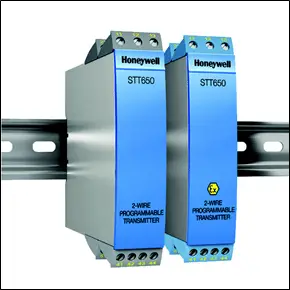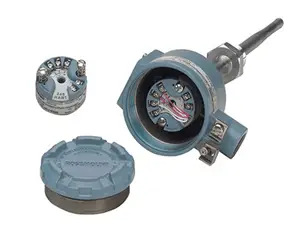A temperature transmitter is an electronic device that receives input from sensors like RTD or thermocouple installed in the field, and converts the received input to a signal which is understandable by the systems like PLC or DCS or ESD. The converted signal is sent to PLC or DCS or ESD for further processing.
No doubt that RTD or thermocouple can be directly connected to Analog Input cards of systems like PLC or DCS or ESD by using appropriate barriers, but what if the distance between RTD or thermocouple and PLC or DCS or ESD is very large.
What will happen to the signal? Or to point out the question is why are the temperature transmitters required?
Yes, correct, a temperature transmitter is needed where the distance between RTD or thermocouple and analog input card is very large, and so to get the most accurate values of the temperature sensed by field sensors like RTD or thermocouple.
How does temperature transmitter work?
Temperature transmitter has an electronics that convert the RTD or thermocouple signal to output like 4 mA – 20 mA signal. The transmitter can also convert the RTD signal into FF signal, Profibus PA signal. It is also possible to convert the signal in any other kind of signal as per the requirement. Thus, the transmitter can output many types of signals as per the user’s requirements.
For example, the Wheatstone bridge converts the RTD resistance into millivolts. Further, the transmitter converts millivolts to proportional 4 mA – 20 mA signal or FF signal.
Generally, the temperature transmitter is calibrated such that 4 mA represents a lower range value and 20 mA represents a higher range value. Thus the output range of the transmitter is 4 to 20 mA.
For example, Suppose for a process, the temperature measurement range required is -150 degree centigrade to 200 degree centigrade, 4 mA will represent -150 degree centigrade and 20 mA will represent 200 degree centigrade (the whole range will be linear)
The old temperature transmitters had had zero and span calibration potentiometer through which the temperature transmitter was calibrated. However, modern transmitters do not have such a facility for zero and span calibration through a potentiometer. Generally, In modern transmitters, we can do the zero and span adjustment through a handheld HART (375 or 475) communicator. Even, it is possible to calibrate the transmitter from a remote. Therefore, it became now easy to calibrate the transmitters.
What is the output of temperature transmitter?
The output of the temperature transmitter can be either 4 mA to 20 mA, 0 VDC to 5 VDC, 0 VDC to 10 VDC, FF signal, and Profibus PA signal. Thus, versatile output of the transmitter facilitates engineer to programme it for different PLC and SCADA.
Different Make and Model Number
Generally, temperature transmitters are classified on basis of inputs they accept, outputs they can generate, features like advanced diagnostics, and mounting options. The user manual can be useful in knowing the functionalities of every model number.
Several most known and widely used make and model numbers of temperature transmitters used in the field are mentioned below.
| Make | Model Number |
| Rosemount | 3144 |
| Rosemount | 644 |
| Rosemount | 248 |
| Rosemount | 648 |
| Yokogawa | YTA110 |
| Yokogawa | YTA310 |
| Yokogawa | YTA320 |
| Yokogawa | YTA610 |
| Yokogawa | YTA510 |
| Honeywell | STT170 |
| Honeywell | STT650 |
| Honeywell | STT750 |
| Honeywell | STT850 |
| Honeywell | STIW400 |
| E&H | TMT85 |
| E&H | TMT71 |
| E&H | TMT72 |
| E&H | TMT112 |
| E&H | TMT162 |
Different Mounting Options
Mainly three types of mounting options are available. These are;
DIN Rail Temperature Transmitter
- DIN-Rail mounting option is one of the oldest types.
- DIN Rail type temperature transmitters are easy to install and consume less space because in a single panel multiple temperature transmitters can be installed. Therefore, it is very easy to install the transmitter in no time.

- DIN Rail type of transmitters are less accurate when compared to other transmitters because longer lead wires are required for connecting the transmitter and field sensor
- DIN rail mount temperature transmitters have very limited functionality and hence their usage is very limited.
Head Mount Temperature Transmitter
- As its name suggests, a Head mount type transmitter is mounted inside the housing of the head in RTD or thermocouple itself.

- Hence, it is possible to access the sensor and transmitter from one place only. This not only makes it user-friendly but also eliminates wiring between sensor and transmitter thereby eliminating the errors induced by the lead wires and reducing cost as well.
Field Mount Temperature Transmitter
- Field mount transmitters have wide applications in many processes where temperatures are very high and not possible to use a head-mount temperature transmitter. Thus, these transmitters are located at a far distance from the measuring point.

- Field mount temperature transmitters have advanced features like advanced diagnostics, remote configuration, burnout function, and many more. Thus, these transmitters are very advanced.
- The main advantage of the field Mount temperature transmitter is that the calibration of the transmitter is possible from a far distance from extreme process conditions (in terms of temperature, and noise) also where a person cannot go and check the head mount type temperature transmitter.
- Lead wire compensation is a very important factor here because the distance between sensor and transmitter can be more also dependent on the installation.
Read Next: